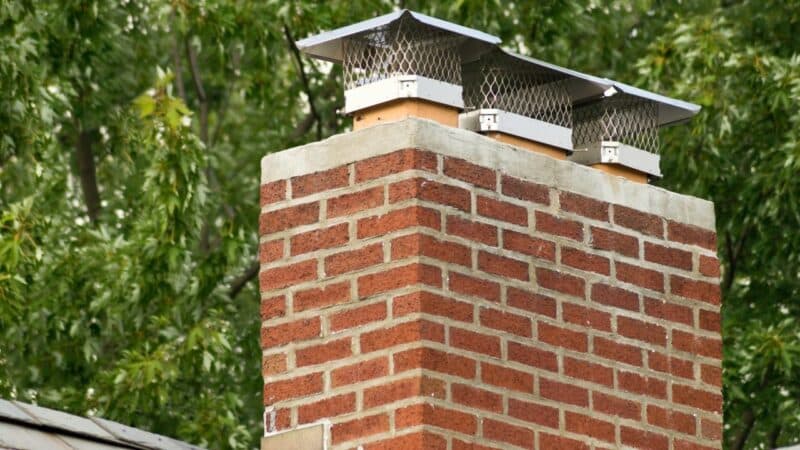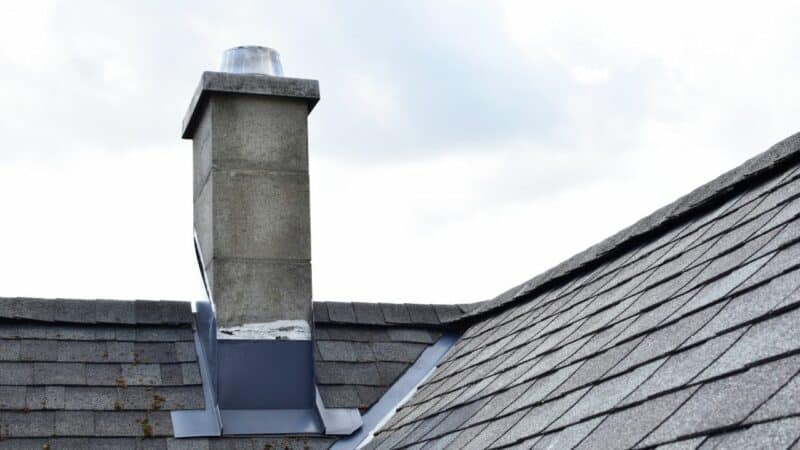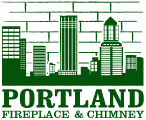Spotting bad chimney repair work is an important skill for a homeowner. Owning a fireplace is a responsibility. And to own those cozy nights and family memories sitting by the hearth you need to recognize when your home is vulnerable to water damage or fire risk because of natural erosion or low-quality work.
As many homeowners who have dealt with recurring issues can attest – not all chimney repair work is executed equally. Low-quality repairs can be more than just a minor inconvenience.
Whether it’s the unmistakable signs of shoddy craftsmanship to the use of inferior materials, there is always a way to tell if you worked with a quality chimney outfit. Understanding how to spot these issues can save you from financial and physical headaches down the line.
In this blog, we’ll guide you through some of the red flags of poor chimney repair, so you can operate with a higher sense of certainty and responsibility related to your chimney and fireplace.
Where Does Poor Quality Chimney Repair Work Often Comes From?
A common misconception lies in the assumption that all home repair professionals possess the same skill set; however, this is far from the truth.
An incredible roofer may deliver an incredible roof but struggle when it comes to the correct flashing application around the chimney. An amazing chimney sweep may not have the specialized knowledge required to handle larger scale chimney repairs. To be sure of a great fit you need a trustworthy company with specialized knowledge that encompasses masonry, roofing, chimney best practices, and the impact it can have on the structural integrity of your home.
This fragmentation of expertise often leads to the multiplication of poorly executed chimney repairs, leaving homeowners in a challenging predicament.
Let’s have an in-depth look at each of these issues;
Chimney Repair Training
Chimney repair training is a specialized field requiring training of chimney maintenance techniques, ventilation systems, and safety protocols. Professionals undergo comprehensive training that not only covers technical skills but also focuses on the unique challenges posed by different chimneys and fireplaces.
Communities like the National Chimney Sweep Guild are designed to help train chimney experts in proper safety protocols and best practices. This training ensures they can diagnose issues onsite effectively and execute repairs that hold up against the elements.
As such, before settling for a chimney repair expert ask for their certifications and qualifications to work on your chimney. However, even if they show the proper qualifications that does not mean they have the restoration or masonry experience needed to execute quality brickwork. We find that many chimney sweeps are not trained in proper masonry and outsource that work to us or a mason. Understanding that distinction is HUGE because bad brickwork makes your whole chimney system vulnarable.
“Roofers Aren’t Masons or Chimney Experts. Masons Don’t do Chimney Repair. Many Chimney Experts don’t do Masonry.”
The problem with most recurring chimney systems boils down to this: Your roofer, your mason, and you chimney expert are qualified to work on their specific task but are not trained to fix the holistic problem which may require all 3 trades. There is no general contractor for chimney problems who can coordinate the trades and collecting quotes and managing work on a chimney repair is outisde the expected scope for every homeowner.
It makes no sense to have beautiful masonry work if the chimney cap is too small. The water will simply roll off and erode your new masonry again.
It equally makes no sense to have your chimney mechanics repaired and your masonry neglected. A broken mortar joint between bricks is a point of vulnerabilty. If you just spent money to have a leak stopped or a flue replaced or creosote removed then you’ll want to have that investment protected by quality mortar.
We have found that even professionals who brand themselves as chimney experts in Portland often lack the essential masonry skills needed to deliver a holistic repair.
- Roofers might lack the specialized masonry and chimney system understanding to waterproof where the roof meets the chimney.
- Masons, while skilled with brick and mortar, might not be versed in the unique needs of chimney repair.
- Some chimney experts lack comprehensive masonry training beyond tuckpointing. Brickwork is crucial for lasting repairs.
So, what do you do here?
To get the highest quality chimney repair, hire a company that you can verify the quality of their entire repair. Portland Fireplace and Chimney are leaders in the northwest and instructors for the National Chimney Guild Association. Check out our qualifications and the quality of our work.
What Does Low-Quality Chimney Repair Work Look Like?
Low-quality chimney repair work often presents itself in visible signs that can be observed without the need for specialized equipment. Here are some things to look for:
- Uneven or mismatched mortar and brickwork.
- Use of materials unsuitable for high temperatures or weather exposure.
- Lingering water damage indicates poor sealing or flashing work.
Our greatest fear would be a low-quality repair that neglects the interior aspects of the chimney, such as the flue or liner, which are critical for safe operation. An incomplete inspection and repair effort may overlook cracks, blockages, or the buildup of creosote from wood combustion or gas fireplaces, which can lead to dangerous chimney fires and/or exposure to harmful carbon monoxide. Such oversights underscore the importance of selecting a qualified and thorough repair service.
Spotting Bad Chimney Repair Work in Portland
Our company has repaired literally thousands of chimneys throughout Portland. Here are the most obvious errors we see homeowners living with:
Your Chimney Cap is Too Small for Portland Weather

In our rainy and windswept climate of Portland, Oregon, the right chimney cap is a necessity. A too-small chimney cap fails to prevent the intrusion of water, debris, and wildlife, which can lead to significant damage and costly repairs.
Generally, an undersized chimney cap doesn’t cover the entire footprint of the crown – they cover only the hole meant to let out the smoke. As such, water drips from that small cap, focalizing it to pound directly on the crown which increases the deterioration of the chimney.
The most obvious signs that you are dealing with a small chimney cap are the continued leaks and cracks in the mortar close to the cap line. Even after the chimney has had recent repairs you’ll quickly see new cracks and leaking because of the improper chimney cap.
In light of this, it’s crucial for homeowners to work with a certified chimney repair expert, who is familiar with the demands of Portland or the local climate they live in. We learned that having an oversized cap adds years to the lifespan of a chimney in Portland and safeguards the home against water, fire, and wildlife-related damages.
They Fixed the Brick and Not the Underlying Issue

Another common mistake in Portland chimney repair work is focusing solely on the cosmetic aspects, such as fixing cracked bricks and tuckpointing, without addressing the root cause of the damage in the first place. This approach might leave a chimney looking as good as new on the outside, but the underlying issues remain unresolved and unmitigated. Over time, this oversight can lead to the same problem as well as even more costly problems. For instance;
- Cracked bricks get replaced without fixing the water leak that caused them. The water damage will return or continue in places you won’t notice.
- Repointing is done or mortar is patched up, but the deteriorated flue liner is ignored. This makes your home vulnerable to fire.
- The chimney cap is replaced, yet inadequate waterproofing still leaves the chimney vulnerable to moisture. It may look complete but the drips off the cap will result in more cracks within 3 years in Portland.
Effective chimney repair demands an understanding of how various components work together to create a safe hearth for the home. Masonry, waterproofing, and structural integrity interact to protect the home from fire hazard and water damage.
Homeowners should be wary of contractors who propose quick fixes for visible damage without conducting a thorough chimney inspection. True expertise in chimney repair involves diagnosing all potential issues, whether they are immediately evident or likely to pose a problem in the future. Proper chimney inspections ensure that all possible issues are identified and repaired.
Caulking Is Not the Same as Roof Flashing or Masonry Flashing
A crucial distinction that homeowners often miss is between caulking and proper flashing methods. Caulking is a sealant used to fill gaps to prevent leaks works best on certain surfaces and not as the main waterproofing method. It can only offer a temporary solution and is not a substitute for the durable protection provided by roof or masonry flashing. Flashing, made from metal or other impervious materials, is expertly designed to guide water away from critical areas for the long-term.
The problem area is where the masonry of the chimney meets the roofline.
Where the wood or roofing material hits the masonry there is a gap. Many untrained techs use caulking there – the same material they are used to using to seal siding boards or small cracks before painting. The problem is that caulking is not designed for brick nor your roofing material. It might seem like a good idea but it will in not too long, especially in Portland, lead to leaking issues.
Without proper flashing installed firmy into the masonry, water can easily penetrate the chimney structure, leading to severe underlying problems such as moisture damage, mold growth, and weakened masonry that could have been avoided with the correct approach.
If you can spot the difference between caulking on your chimney and appropriate flashing you will be able to protect yourself from temporary fixes and ensure you are getting the real thing. I’ve included some photos below of proper flashing istallation in Portland.
Generic Materials Were Used on Your Roofline
One revealing sign of low-quality chimney repair is when non-specific or generic materials are used on the roofline, rather than materials that are correctly designed to adhere to the existing roof. The disparity of materials leads to aesthetic mismatch and severe functionality issues that compromise the roof’s integrity and the chimney’s efficiency.
The right choice of materials is crucial for ensuring that the repair work not only lasts but also integrates seamlessly with the rest of the home. When incorrect materials are chosen, it may initially seem like a cost-saving measure, but ultimately, it leads to increased expenses due to premature wear and tear, leaks, or even structural damage:
| Material Used | Problems Caused | Long-term Consequences |
|---|---|---|
| Generic Sealants | Insufficient sealing, aesthetic mismatch | Water damage, increased repair costs |
| Mismatched Roofing Materials | Poor integration, potential leak points | Structural damage, reduced roof lifespan |
Spotting this issue requires a discerning eye and an understanding of the materials that are compatible with the specific types of roofing involved. Homeowners should seek out professionals who not only have proficient repair skills but also a deep knowledge of materials and how to appropriately match them to the existing structures.
You See the Same Issue Occurring Every Year
One unmistakable sign of subpar chimney repair work is the recurrence of the same issue. This persistent problem not only signals an initial failure to address the root cause but also highlights a lack of follow-through. Homeowners facing repetitive issues are often victims of quick fixes.
Efficient and durable chimney repairs require a comprehensive understanding of the chimney’s structure and the various factors that can lead to its deterioration. If homeowners notice the same complications, such as water leaks or cracks, appearing repeatedly, it likely means the initial repairs were superficial and that the damage is worse than it was when it was first repaired.
One of our clients hired us when they noticed their masonry crumbling despite having had it repaired a few years earlier. We came out to inspect the work and immediately noticed that not only was the brickwork cracking all the way to the base, but the chimney had developed a lean. What happened was the disintgrating mortar had compromised the structural integrity of the chimney. When they put new grout on the side of the brickwork that was in the worst condition it caused the brickwork to lean slightly. What the homeowner thought was another routine masonry job turned into a full chimney restoration from top to bottom. We hauled out scaffolding and had our team on there painstakingly removing the compromised blocks and rebuilding the chimney from scratch in order to protect the home and any pedestrians from a falling chimney.
If you notice the same repairs being needed every couple years you may certainly have a problem. Schedule an inspection and chimney cleaning on a yearly basis to avoid dramatic rebuilds and danger.
How to Prevent Low Quality Chimney Repair Work
The best way to prevent low quality chimney repair work is to hire contractors with current chimney-specific qualifications. A solid technican should be certified by the Chimney Safety Institute of America, attend regular continuing education trainings with the National Chimney Sweep Guild, and ideally be a member of the Oregon Chimney Sweeps Association. Regulations change and chimney manintenance is a craft that carries an awareness and diligence. This is in addition to having an Oregon State CCB, and proper insurance.
Without such qualifications, a contractor might not be fully equipped to diagnose or rectify complex chimney problems, leading to temporary fixes rather than sustainable solutions.
Homeowners need to verify the qualifications and experience of chimney repair services before entrusting them with the safety and functionality of their chimney. Asking for proof of chimney-specific qualifications can save you from the pitfalls of shoddy workmanship that could endanger your home and family. Professionals with the right qualifications will confidently provide evidence of their expertise, ensuring that your chimney is in capable hands.
Proof of our chimney-specific qualifications:
President of Oregon Chimney Sweeps Association
Conclusion
When looking for chimney repair services in Portland, Oregon, don’t be in a hurry to pick just any contractor that comes your way. For starters, Portland’s weather can be unforgiving, especially for your chimney. This means that your repairs need to be undertaken by someone with the right skills and knowledge of chimney repairs as well as how the weather in the area affects the repairs.
At Portland Fireplace and Chimney, we offer just that. We are among the best chimney sweeps and also the best chimney repair professionals in Portland. Whether you need a chimney foundation repair, chimney cap repair, or any wood stove repairs, we are the experts to contact.
Contact us today and get your chimney problem solved by the best in the market.
FAQ
Who fixes chimney leaks?
Fireplace and chimney experts like the chimney sweeps -They are trained to clean and inspect chimneys. They can identify leaks and make repairs to the masonry or crown of the chimney to prevent water intrusion. Sweeps have the right equipment like scaffolding to access the chimney. However, ensure that they have the right expertise and qualifications.
Is chimney repair covered by a home warranty?
Well, this depends on the type of home insurance policy and the type of damages covered. Most basic home insurance covers exclude chimney repairs.
Can a roofer fix a chimney?
Yes. However, since they are not trained to deal with the complexities of a chimney repair, they will, most probably, offer low-quality repair work. You might need to do another repair soon.
Can chimney cracks be repaired?
Yes, they can. However, you need to ensure that you get chimney repair services from qualified chimney repair experts. Otherwise, you might keep repairing the same issue over and over again.

Portland Fireplace and Chimney Inc is your top notch pick for a fireplace and chimney company in the greater Portland metro area.

